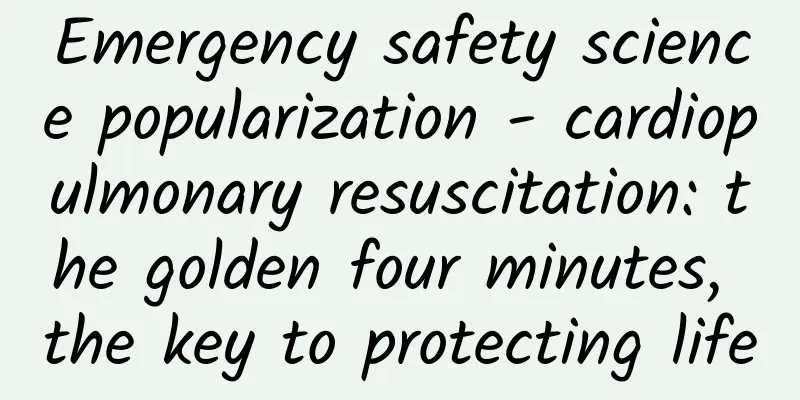Emergency safety science popularization - cardiopulmonary resuscitation: the golden four minutes, the key to protecting life

|
In an emergency, every second matters. Cardiopulmonary resuscitation (CPR) is a life-saving first aid skill that can save lives in the event of cardiac arrest. This article will show you the correct steps and importance of CPR, helping you become a life saver at a critical moment. 1. The Importance of Cardiopulmonary Resuscitation Cardiac arrest is one of the leading causes of death worldwide, with an annual incidence of out-of-hospital cardiac arrest of 30.0 to 97.1 cases per 100,000 people. If cardiac arrest patients receive timely and effective cardiopulmonary resuscitation and other measures, the spontaneous circulation recovery rate and survival rate of cardiac arrest patients will be improved. Within 1 minute after cardiac arrest, immediate cardiopulmonary resuscitation (CPR) and first aid using an automated external defibrillator (AED) can achieve a 90% success rate; the success rate decreases by 10% for every 1 minute of delay. 2. Correct steps for cardiopulmonary resuscitation Assess the environment and the patient's condition : Before rescuing a patient, first assess the surrounding environment and ensure your own safety; then transfer the patient to a safe and easy-to-rescue location, and place the patient on a relatively hard surface. Determine consciousness and breathing : Pat the patient's shoulders with both hands, and call out to both ears in turn: "Hey! What's wrong with you?" Observe whether the patient responds, and the judgment time should not exceed 10 seconds. Observe whether the patient's chest rises and falls, and the judgment time should not exceed 10 seconds. Call for help : Before performing cardiopulmonary resuscitation on the patient, do not forget to ask people around you to quickly call 120 emergency number. Chest compression, airway opening, artificial ventilation : Chest compression : The compression frequency is 100-120 times/minute, and the compression depth is 5-6cm of the sternum depression depth. After the compression, ensure that the rescued person's sternum rebounds completely. Artificial ventilation : Mouth-to-mouth artificial ventilation is used outside the hospital: pinch the patient's nostrils, completely cover the patient's mouth after natural inhalation, blow air into the patient's lungs, and lift the patient's chest; after blowing, release the fingers that pinch the patient's nostrils to see his chest rebound. Defibrillation : 80% of cardiac arrest patients will experience ventricular fibrillation (VF). If a defibrillator is used, VF can be eliminated and sinus rhythm can be restored. Early defibrillation can play a key role in the patient's resuscitation. 3. Precautions for cardiopulmonary resuscitation Minimize interruptions in chest compressions and ensure that chest compressions are performed for >80% of the time during the entire rescue process. Avoid hyperventilation and limit ventilation to no more than 10 breaths per minute. If conditions permit, one person can be rotated every 2 minutes to perform chest compressions to ensure the high quality of CPR. IV. Conclusion CPR is not just a doctor's job, it is a skill that everyone should master. In an emergency, correct CPR can save lives. Let us work together to make CPR an essential survival skill for everyone and jointly protect the hope of life. |
<<: I have the flu and my bones ache all over. What's going on?
Recommend
It is best to take vitamin C in four situations!
Vitamin C is a nutrient that has certain effects ...
Obvious bleeding after exercise during ovulation
The ovulation period is generally fourteen days a...
Pink vaginal discharge before menstruation
Menstruation is something that non-pregnant women...
What to do if a woman has a stomachache during menstruation
Dysmenorrhea is a common phenomenon among women. ...
Hula hooping will make your butt bigger
Nowadays, many girls like to lose weight for thei...
Does it matter if you have sex once during your period?
Menstruation is a special period for every woman....
High testosterone in girls
Everyone has a certain amount of male hormones an...
There are many benefits of eating vinegar every day, but don't eat it like this! Choosing vinegar and eating vinegar, just read this article
This article was reviewed by Wang Wenxiang, profe...
Medical abortion in Guangzhou is a good choice
For female friends in the early stages of pregnan...
Oops, I squinted! Is it over after I “squinted”? Where did the foreign object that got into my eye go…
Autumn is here and the wind is getting cooler. It...
What is the reason for a small lump in a woman's groin?
In daily life, the appearance of small bumps in t...
Do I need to take anti-inflammatory drugs when I have a fever, cold, or cough?
Do I need to take anti-inflammatory drugs when I ...
Is foot bath good for patients with vaginitis?
Vaginitis is a typical gynecological disease with...
Benefits of drinking coconut water for women
Nowadays, everyone pays great attention to health...









